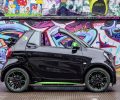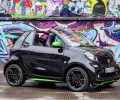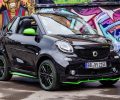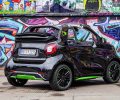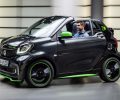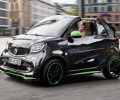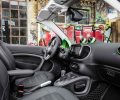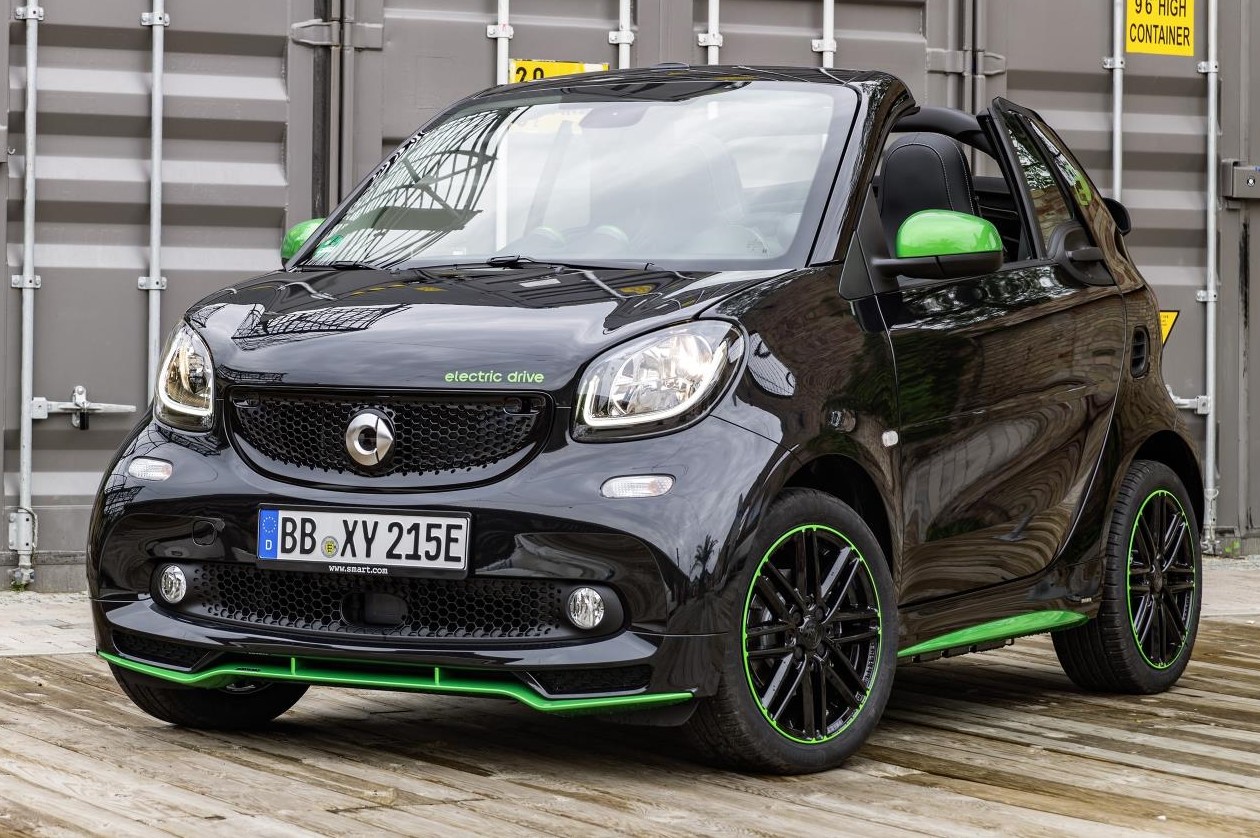
Electrification of all smart models
September 22, 2016 – Stuttgart/Paris
The new smart electric drive makes opting into electric mobility more attractive than ever, combining overall agility with emission-free driving as an ideal combination for urban mobility. The smart fortwo electric drive is now available on the new-generation smart platform in both the smart fortwo coupe and cabrio models and, for the first time, in the smart forfour (not available in the U.S.). With this next generation, smart will be the only car manufacturer worldwide to offer its entire model range with both combustion engines and pure battery-electric drive. The smart electric drive will celebrate its world premiere at the Paris Motor Show and market launch of the smart fortwo coupe electric drive will start in the U.S. in spring 2017 and the smart fortwo cabrio electric drive in summer 2017.
“The smart is the ideal city car, and with electric drive it becomes a little bit more perfect,” says Annette Winkler, Head of smart. “This is why we will soon be offering our entire range – smart fortwo, smart cabrio and even our smart forfour* – as all-electric versions. Together with lots of smart fans and enthusiastic drivers of the predecessor generations, we are looking forward to the unique driving fun offered by the new smart electric drive at very attractive prices, especially in countries where there is a buyer’s premium.”
The most important information at a glance:
- smart is the only car manufacturer worldwide to offer its entire model range with both combustion engines and pure battery- electric drive.
- The smart fortwo cabrio ED is the only electric cabriolet on the market.
- With 118 lb-ft torque and 80 hp, the electric car boasts exceedingly agile acceleration.
- The fully charged battery has sufficient power to cover approximately 99 miles (or 160 kilometers in accordance with the NEDC), making it ideal for urban use. U.S. range and overall electric motor specifications will be announced at launch.
- With the high-performance on-board charger, the smart electric drive can be charged in half the time as before (U.S. preliminary new generation charge time: 2.5 hours / previous generation charge time: 5.5 hours)
smart electric drive: agile, quiet and emission-free urban driving
The driving characteristics are as agile and lively as ever. The ultra- small turning circle also contributes to this, and at 22.8 feet for the two- seater it corresponds precisely to that of its sibling with conventional drive. Electric driving at smart offers maximum options for customization with regard to colors and optional equipment due to exclusive options and tridion paint colors offered on the electric drive model.
Charging time is an important factor for electric vehicle customers and the new smart electric drive also boasts major improvements here. All models have a new, powerful on-board charger as a standard feature. In the U.S., charging time is an estimated 2.5 hours – twice as fast as the predecessor. With the “smart control” app the charging process can be conveniently monitored from afar and many more functions, such as intelligent charging, can also be controlled remotely.
The smart fortwo electric drive models are series produced at smart’s Hambach plant. The smart is equipped with a battery from the Daimler subsidiary Deutsche ACCUMOTIVE. The company based in Kamenz, Saxony has been building the electric heart of the smart electric drive since 2012.
An 80 hp electric motor works at the rear of the smart electric drive and transmits its power via a constant ratio to the wheels. Powerful torque of 118 lb-ft is immediately available from a standstill, a 19% increase over the 96 lb-ft offered by the previous generation smart ED. The electric drive has a range of approximately 99 miles (Euro NEDC cycle) – ideal for emission-free mobility in urban areas. The maximum speed is electronically limited to 81 mph to maximize the range. U.S. range and overall electric motor specifications will be announced at the time of launch.
Thanks to the power characteristics of the electric motor, the smart needs just one single fixed gear ratio. There is no need for any gear changing – a major advantage in dense city traffic. To reverse, the engine’s direction of rotation changes.
The data for the new smart electric drive at a glance:
| smart electric drive | fortwo | fortwo cabrio |
| Motor | three-phase synchronous motor | |
| Battery | Lithium-ion battery | |
| Battery capacity (kWh) | 17.6 | |
| Output electric motor (hp) | 80 | |
| Torque electric motor (lb-ft) | 118 | |
| Acceleration 0-60 mph (sec) |
11.4 | 11.7 |
| Range in miles (approx.) | 99* | 96* |
| Maximum speed (mph) | 81 | |
| Charging time, 20-100%, 110V household socket (hours) |
22 (U.S. preliminary) | |
| Charging time, 20-100%, 240V wallbox (hours) | 2.5 (U.S. preliminary) | |
* Euro NEDC cycle. U.S. range and overall electric motor specifications will be announced at the time of launch.
In addition to the basic transmission mode, the driver can select ECO mode. This is designed for a particularly efficient driving style. In addition, the maximum speed is limited, the accelerator pedal curve adjusted and the maximum recuperation level is pre-selected. In overrun mode or when braking, the vehicle’s kinetic energy is converted into electrical energy – this is called recuperation.
To save energy and extend the range, the smart electric drive also features pre-entry climate control. For example, this enables the desired temperature to be reached in the interior while the vehicle is still charging at a socket.
With the “smart control” app, lots of electric drive information can be called up via smartphone, tablet or PC and functions such as pre-entry climate control or intelligent charging can be conveniently controlled remotely. The new model has more operating options than the predecessor. For example, two programmable departure times mean that intelligent charging and pre-entry climate control do not always need to be reset for frequent journeys.
The smart electric drive models surpass the extensive standard equipment of their siblings with conventional drive as they additionally have a dashboard instrument with power meter and battery status display (standard) or on request the winter package with heated steering wheel for maximum climate comfort (optionally available). The electric drive design package (optionally available) gives the vehicle an expressive look with tridion safety cell and door mirror caps painted in exclusive electric green.
After the world premiere in Paris, the new smart fortwo electric drive will be launched in the U.S. in spring 2017 and the smart fortwo cabrio electric drive in summer 2017.
UPDATE: November 14, 2016
Perfect drive for the perfect city car
With the new “smart control” app lots of electric drive information can be called up via smartphone, tablet or PC and functions such as pre-entry climate control or intelligent charging can be conveniently controlled remotely.
Under the microscope: The “smart control” app
Permanent online connection to the smart
With the new “smart control” app lots of electric drive information can be called up via smartphone, tablet or PC and functions such as pre-entry climate control or intelligent charging can be conveniently controlled remotely. The new model has more operating options than the predecessor. For example, two programmable departure times mean that intelligent charging and pre-entry climate control do not always need to be reset for frequent journeys.
The “smart control” app enables simple operation of lots of functions of the smart electric drive. smart drivers can see the current battery state of charge and the range before they set off or activate the pre-entry climate control of the interior while the car is charging.
The most important functions at a glance:
- Vehicle information: battery charge level, range, average fuel consumption, mileage, eco score, next service, tire pressure.
- The vehicle functions departure time and pre-entry climate control: compared with the previous series, two programmable departure times mean that these functions do not always need to be reset for frequent journeys — for example, a daily commute. The programmed departure time can be used both for intelligent charging and for pre-entry climate control. If the departure time is set the previous evening, the vehicle has a perfect interior temperature the next morning. If the customer wants to spontaneously set the temperature before a trip for a vehicle that is not connected to a charging station this can also be done via the “smart control” app as long as the battery charge level is at least 30%. Under the microscope: Pre-entry climate control
Cozy warmth when you’re ready to set off
The “smart control” app can also be used to conveniently set the pre-entry climate control for the interior of the smart electric drive. Energy-intensive climate control is set to pre-departure if possible during the charging time of the high-voltage battery, which has a positive effect on the range.
When the smart electric drive is connected to the charging network, the pre-entry climate control can be activated particularly conveniently with the help of a planned departure time. The planned departure time can be entered via the instrument cluster or the “smart control” app. When the departure time has been entered, the controller becomes active approximately two hours before this time. The pre-entry climate control starts up to an hour before the departure time by determining the time needed for this based on the temperature difference between the inside of the vehicle and the outside temperature. Depending on the difference, the rear window, the seats and the steering wheel are heated, for example, or the interior is cooled. The target temperature is about 70° Fahrenheit.
Spontaneous pre-entry climate control without a pre-programmed departure time is also possible when the vehicle is not connected to the charging network. In this case the pre-entry climate control time is limited to five minutes. The function is conveniently activated via the “smart control” app on a PC, tablet or smartphone. The target temperature for the interior is also 70° Fahrenheit.
The smart electric drive has an energy-efficient air conditioning system. An electric heater booster (high-voltage PTC; Positive Temperature Coefficient) heats the interior while an electrically powered AC compressor cools it.
In ECO mode the outlet air temperature from the air vents is lowered or raised to reduce the energy consumption.
smart family
Electrification of the entire model range
The new smart electric drive makes opting into electric mobility easier than ever as it combines the unique agility of the smart with local emission-free driving – the ideal combination for urban mobility. Zero-emission driving fun can be experienced not only in the smart fortwo and smart fortwo cabrio, but for the first time also in the four-seater smart forfour (not available in the U.S.). In the future, smart will be the only car manufacturer worldwide to offer its model range with both combustion engines and pure battery-electric drive.
Short overhangs, a minimal length and a high steering angle are optimal prerequisites for ensuring that the new smart models get around every corner and into every parking space. The new smart fortwo electric drive (length/width/height: 106.1/65.6/61.2 feet) sets a turning circle benchmark at 22.8 ft. from curb to curb that makes turning maneuvers extremely simple. The characteristic proportions offer outstanding visibility and maneuverability and, together with the rear engine, enable a comfortable amount of space for such compact dimensions.
The new smart generation was introduced in 2014 and is characterized by a one-and-a-half box design – an evolutionary development of the typical smart silhouette. The higher hood lends the smart a more grown-up and sportier character. The color contrast between tridion cell and body panels is another characteristic feature of the smart brand.
The smart displays a friendly but self-assured face. A decisive feature of this friendly face is the signature smart grille with the large logo. The grille’s perforated structure results from a honeycomb pattern.
The rhombic front lamps are truncated slightly at the top, producing an attractive sporty look. The U-shaped daytime driving lights add a characteristic design feature.
“Loop” is the designers’ name for the emotional sweep that features as a leitmotif in the interior, embellishing the dashboard and doors. The sculptural dashboard itself consists of two sections – a bold and sensuous outer section which can optionally be covered with fabric, and a large, concave inner section incorporating the functional elements.
The dashboard and the door center panels feature extensive fabric coverings. This high-quality textile surface is very pleasant to the touch and is reminiscent of the mesh inserts in modern sports shoes. The color and material concept underscores the easy-going and charming character of the new smart generation.
The essential safety concept embodied so successfully by the preceding models has been retained. Like a nut, the interior is protected from harm by a rigid shell: the tridion safety cell. A high proportion of ultra-high strength hot-formed steels and maximum-strength multiphase steel is now used on the new smarts. In keeping with the Mercedes-Benz “real-life safety” philosophy, the focus on car-to-car crash tests was on compatibility with substantially larger and heavier vehicles. The new smart vehicles performed well in frontal collisions with the S- and C-Class.
The battery of the electric smart is housed centrally under the front seats – ideal for a low center of gravity and balanced handling. It is supported by an all-round, crash-absorbing frame. The frame structure is made of modern high-strength steel tubes that give the battery all-round protection with the profiles used and also absorb and distribute intrusion forces in the event of an accident.
Sound generator: safety in traffic-calmed zones
On account of its quiet drive, the new smart electric drive comes standard with an acoustic warning. The sound generator is a cubic component on the right-hand side behind the radiator grille; it consists of a weatherproof loudspeaker and an integrated controller. It generates a smart-specific sound for the protection of other road users: This sound is speed-dependent. The pitch and volume increase as the vehicle speed increases. Above about 18 mph the sound is automatically masked as rolling noise and wind noise predominate from this speed.
Advanced assistance systems which were previously the reserve of higher classes of vehicle further enhance safety and comfort. These include Crosswind Assist (standard) and the optional forward collision warning.
A front axle design adopting elements from the former Mercedes-Benz C-Class, a De Dion rear axle, long spring travel all round and an unprecedented small turning circle are the highlights of the chassis.
Equipment and features
Maximum scope for individualization
The smart electric drive models surpass the extensive standard equipment of other smart fortwo models with conventional drive as they additionally have a dashboard instrument with power meter and battery status display (standard) or the climate package with heated steering wheel for maximum climate comfort (optionally available). The electric green tridion cell is exclusive to the electric drive, which gives the vehicle an expressive look.
Like all models of the current smart generation, the electric drive versions come with extensive safety and comfort equipment. The standard equipment includes power steering, LED daytime driving lights, central locking with radio remote control, visual locking-verification signal and immobilizer, cruise control, and dashboard-mounted power meter and clock.
In addition, the smart electric drive models have several special features such as the dashboard instrument with power meter and state of charge. It is next to the A-pillar trim on the dashboard. The electric power recuperated is displayed on the left side of the power meter and the electric power currently called up is shown on the right side. LEDs between the segments show the available power and power that can be called up. The battery charge status is displayed in the lower part of the dashboard instrument.
A color 3.5-inch display in TFT technology (Thin-Film Transistor) with a trip computer is available as standard equipment. Additional functions include:
- Extended display of the charging rate
- Display of the battery charge level with animated battery icon
- Detailed specific eco score for the electric vehicle
- Energy flow display including auxiliary consumers with digital values
- Setting and display of pre-entry climate control and smart charging in conjunction with entering a departure time.
Electric drive customers who opt for the smart Media-System with a 7-inch color display and touchscreen operation can also look forward to several additional functions:
- The current range can be considered in the selection of navigation destinations
- Charging stations can be added as intermediate destinations
- Navigation to the nearest charging station with the first battery reserve warning
- Charging station search based on POIs on the SD card
- Graphic representation of the range on the navi map.
A standard feature on board all smart electric drive models is a cable and rigid cable bag that is open at the back. The cable bag is accommodated in the luggage compartment on the right-hand side in the direction of travel. It is fastened in the luggage compartment with two quick-release fasteners, a retaining strap and Velcro strips and can be removed if necessary. The surface is made of stain-resistant material.
These packages offer even more utility value:
- Climate package: heated steering wheel, additional door and floor insulation for climate system efficiency – exclusively available on smart electric drive
- Lighting package: LED daytime running lamps and LED taillamps, fog lights with cornering function
- smart Media System with JBL Sound System: smart touchscreen media system, JBL sound system
All three lines offer opportunities for differentiation in the pure, passion and prime trim lines are available on the smart electric drive, which provide for visual differentiation, as with the combustion engine models. The most important features at a glance:
- The base pure trim line offers a choice of black cloth or black man-made leather upholstery, multifunction steering wheel, automatic climate control and dashboard mounted power meter and clock
- The passion line has a very stylish and modern interior with a choice of color combinations in black/orange, black/white or black/black cloth. It builds upon the pure line with a leather multifunction steering wheel, height adjustable driver’s seat, electric and heated side-view mirrors, retractable cargo cover and 15″ 8-spoke wheels with black accents
- The prime line defines itself as an innovative trendsetter with an interior featuring black leather with grey topstitching. Highlights include the panorama sunroof, ambient interior lighting, heated seats and LED daytime running lights and LED taillamps.
Under the microscope: Deutsche ACCUMOTIVE
Energy storage from Saxony
The battery for the new smart electric drive comes from the Daimler subsidiary Deutsche ACCUMOTIVE. Because as well as in-house development and production expertise and the module strategy for alternative drives it is part of Daimler’s philosophy to secure direct access to key components for electric mobility. With Deutsche ACCUMOTIVE Daimler has sound expertise in the development and production of highly complex drive batteries.
On a growth path: Daimler is currently investing €500 million in the construction of a second battery factory in Germany and is therefore greatly expanding the production capacities for lithium-ion batteries from Deutsche ACCUMOTIVE GmbH & Co. KG. Deutsche ACCUMOTIVE, founded in 2009, is a 100% subsidiary of Daimler AG with sites in Kirchheim/Nabern (research and development) and Kamenz (production).
The company develops and sells highly complex drive batteries based on lithium-ion technology for hybrid and electric vehicles of the Mercedes-Benz and smart brands. Since the start of series production in 2012 more than 75,000 lithium-ion batteries have been delivered. The Daimler subsidiary employs more than 420 staff – 330 thereof in Kamenz. From 2017 all battery systems for Mercedes-Benz and smart will come from Deutsche ACCUMOTIVE.
In 2015 Daimler entered the new field of business with stationary battery storage, opening up additional growth opportunities outside the automotive industry.
Under the microscope: the smart electric drive in studies
Good marks in surveys
The new smart electric drive is globally the fourth generation of electric mobility for smart. It goes without saying that the experiences of previous users were considered in the development of the new models – with several studies confirming that smart electric drive drivers are extremely happy with their purchase decision.
Buyers of the last generation smart fortwo electric drive expressed above average satisfaction with their vehicle, first and foremost due to its environmentally friendliness (79%), followed by the acceleration (75%) and the quiet drive (75%) according to the results of an internal survey of buyers of new smart cars in 2015. In addition to the advantages of electric drive such as the drive/motor (40%) and low emissions (20%), classic smart strengths such as compact dimensions (31%) and maneuverability (28%) were among the top buying reasons.
In contrast, the Technical University of Dresden examined the everyday practicality of electric vehicles in a study. In November 2015 the two authors, René Pessier and Armin Raupbach, interviewed precisely 685 drivers of electric cars in Europe on topics such as purchase decision-making parameters, driving and usage behavior and charging infrastructure. Here are some of the results:
- Most respondents use a further vehicle in addition to the electric car, almost half of them (49.7%) a vehicle with conventional drive.
- In terms of general satisfaction with the vehicle the smart electric drive is above average and ranks fourth out of the nine electric vehicles considered. It therefore leads the line-up of German electric cars.
- In 2015 there were numerous international incentives to buy electric cars. The respondents give these as an important reason for buying in the countries where buyers benefit from them. In contrast, in Germany in 2015 personal conviction regarding electric mobility was cited as the primary motive for buying a vehicle.
- Private charging clearly dominates. In Germany only every third driver has access to all kinds of charging infrastructure, although internationally this figure rises to almost every second driver. A wallbox at home is the primary source of charging current. Due to the regular usage, this and charging at the workplace are of decisive importance.
A survey by the digital association Bitkom in 2016 showed great interest in electric cars in Germany. Although German consumers are still reticent about buying them, electric cars could soon change the face of the city. According to the Bitkom survey approximately 7 out of 10 Germans (69 percent) could imagine buying an electric car.
However, a prerequisite for 62 percent of the respondents is that they are able to travel a similar distance with a battery charge as with a conventionally powered vehicle. 47 percent would buy an electric car if it were no more expensive than a comparable car with a petrol or diesel engine. A further prerequisite for 37 percent is that the vehicle has a similar level of comfort to a conventional car – for example as regards spaciousness and equipment.
The basis for the information is a study carried out by Bitkom Research on behalf of the Bitkom digital association. 1010 people aged 18 and over were interviewed including 773 car drivers. The survey is representative. The question asked was: Could you imagine buying an electric vehicle?
The holistic philosophy
Powered by the wind, from the car to the grid
Daimler keeps thinking ahead with electric mobility in innovative projects. For example, used smart electric drive batteries are given a second life outside the vehicle as 2nd use battery storage. A “live replacement parts warehouse” for battery systems from the third smart electric drive generation also serves to compensate fluctuations in the German grid. This efficient double usage improves the life cycle assessment and also the life cycle costs of e-mobility. Four years ago Daimler acquired a wind turbine which is used to test CO2-neutral mobility over the entire life cycle of the last smart electric drive model series in the framework of a pilot project.
The life cycle of an e-vehicle battery needn’t end with operation in a car; the batteries can be further used for stationary battery storage. Because with this type of use slight loss of power is not important, which means that cost-effective operation in stationary applications is possible for an estimated additional ten years. The further use of the lithium-ion modules enables their economic use to be virtually doubled.
The world’s largest 2nd use battery storage facility is currently being set up in Lünen, Westphalia. Systems from second generation smart electric drive vehicles are bundled in Lünen to create a stationary storage facility with capacity of 13 MWh. A joint venture between the partners Daimler AG, The Mobility House AG and GETEC will start operation of the stationary storage on the site of REMONDIS SE before the end of the year and sell it on the German primary regulation energy market.
Live replacement part store
Battery systems that have not yet been fitted in electric cars but are kept as replacement parts can also find a second use as energy storage systems. Before the end of the year the cooperation partners Deutsche ACCUMOTIVE and enercity (Stadtwerke Hannover AG) will start the construction of a new battery storage facility. The special feature: this is a replacement part store for electric mobility battery systems. Around 3000 of the battery modules kept for the third smart electric drive generation are bundled to create a stationary storage facility at the enercity site in Herrenhausen. With total storage capacity of 15 MWh the facility is one of the largest in Europe. Upon completion the energy storage will be marketed on the German primary regulation energy market (PRL). At the same time thanks to the controlled charge cycle the battery modules remain fresh for possible use as a replacement part in a smart.
The business model thus makes an important contribution to stabilizing the power grid and making electric mobility an economically viable proposition. With increasing fluctuations in electricity feed from renewable energy sources such as wind and sun, such storage units serve to optimally regulate a power frequency that must be kept constant.
Green electricity from a wind turbine
Zero-emission individual mobility – from the well to the wheel – is possible with renewable energies such as sun and wind. In 2012 Daimler AG bought a wind turbine as part of a pilot project in North Bavaria which generates enough electricity to power around 2500 smart electric drives. In this way Daimler and smart are sending a clear signal that CO2-neutral mobility is possible with electric cars.
The wind turbine is currently operated by Primus Energie and is located in the Windpark “Oberland I” (municipality of Helmbrechts) around 150 meters from the A9, the main transport artery between Munich and Berlin. With nominal output of 2.3 megawatts per year the onshore wind energy plant type Enercon E82 generates enough green electricity to run approximately 2,500 smart fortwo electric drives until the end of their life cycle.
The heritage
Powered by electricity since 2007
With the start of the first electrically driven test fleet in 2007 in London, smart also took on a pioneering role in the field of electric mobility. As early as 2005 the company presented the smart electric drive as a one-off vehicle. In 2009 smart launched the second generation of the smart fortwo electric drive, with the model introduced in 18 markets. From June 2012 the third generation of the smart fortwo electric drive also succeeded in winning wide-ranging buyers for its innovative and forward-looking drive concept.
In 2007 a vision that the company had from the very beginning and that was always planned for in the design became a reality: urban mobility with zero local emissions. Still based on the first smart generation, the company started a project with 100 smart electric drives in London. The cars were used by numerous customers, including the London police.
The smart electric drive came with everything that makes a smart a smart – but it didn’t have a combustion engine. A 41 hp magnetic motor worked at the rear of the smart fortwo ed which was driven by a constant high-performance, high-temperature battery made from environmentally compatible sodium-nickel-chloride. It was accommodated in the underbody, which meant that the interior space was not compromised. Boasting NEDC consumption of just 12 kilowatt hours per 100 kilometers and zero carbon dioxide emissions, the smart fortwo ed represented the most economical and climate-friendly alternative in urban traffic. When charged, the two-door car could travel around 115 kilometers (EUDC). When the battery was empty, it could be charged at any 230 volt power socket – at least 1,000 times. This means that the battery could last for up to ten years. It took four hours to charge the battery to 80 percent capacity and eight hours to charge it to full capacity.
The acceleration from zero to 60 km/h was at the same level as the petrol version, the maximum speed was 112 km/h. Furthermore, as a zero emission car the smart fortwo ed enjoyed tax advantages in many countries and was exempt from local restrictions such as the London congestion charge. The small electric car therefore offered a combination of agility, economy and environmental compatibility that is unique in this class.
2008: The smart fortwo electric drive entered series production
At the Paris Motor Show in 2008 smart presented the latest smart fortwo series with electric drive to an international audience for the first time. In real-world driving the zero-local-emission smart fortwo electric drive initially demonstrated its advantages in the project “e-mobility Berlin.” This underlined the leading role of the young car brand on the way to environmentally friendly, sustainable concepts for individual mobility of the future.
Market launch followed in 2009, the model was launched in 18 markets. The objective was to gather as much experience as possible about how customers use and charge electric vehicles. The huge demand exceeded all expectations. Instead of the planned 1,000 vehicles more than 2,000 smart fortwo electric drives were produced in Hambach.
2012: The third-generation smart fortwo electric drive is launched
12 June 2012 – this date marked the starting signal for the first real alternative to the usual refueling stops. The launch of the new smart fortwo electric drive meant that smart customers could now enjoy even more fun at the wheel of an attractively priced vehicle that had the familiar compact dimensions – as a coupé or a cabriolet. With its 55 kW electric motor the smart fortwo electric drive accelerates from 0 to 60 km/h in 4.8 seconds, and with a maximum speed of 125 km/h driving pleasure is also guaranteed on urban motorways. The 17.6 kWh battery enables the urban two-seater to travel approximately 145 kilometers in city traffic without producing any local emissions. The new sale&care model makes opting into electric mobility particularly attractive: it offers customers an opportunity to buy, finance or lease the vehicle at an attractive price and to rent the battery for a monthly fee.
Moreover, in 2013 the smart fortwo was the first all-electric vehicle from a European importer in China. In Germany, the electric smart established itself as the market leader among battery-electric vehicles within a very short space of time with a market share of around 40 percent and was able to maintain this position for three years in a row. At times the sales figures for the smart fortwo electric drive in the USA accounted for 25 percent of all smarts sold there. In 2014 and 2015 the “American Council for an Energy-Efficient Economy” voted it the “most environment-friendly car in the USA” twice in succession.
The smart electric drive also contributed to the success of the brand as part of the car2go fleet with 1,400 cars in three cities. As car2go vehicles alone, the smart electric drive has covered more than 21 million miles in demanding everyday usage since the launch.



